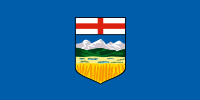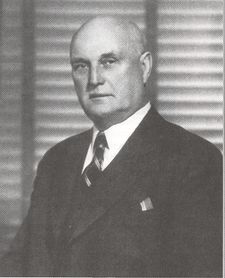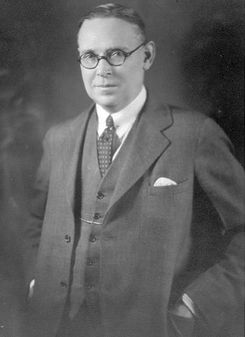List of premiers of Alberta

The list of premiers of Alberta consists of all thirteen leaders of government of the Canadian province of Alberta, Canada since it was created in 1905. Alberta uses a unicameral Westminster-style parliamentary government, in which the premier is the leader of the party that controls the most seats in the Legislative Assembly. The premier is Alberta's head of government, while the Queen of Canada is its head of state and is represented by the Lieutenant Governor of Alberta. The premier picks a cabinet from the elected members to form the Executive Council of Alberta, and presides over that body.
Members are first elected to the legislature during general elections. General elections must be conducted every five years from the date of the last election, but the premier may ask for early dissolution of the legislative assembly. An election may also happen if the governing party loses the confidence of the legislature, by the defeat of a supply bill or tabling of a confidence motion.
A leader of a party is decided upon by an internal constitution unique to each party that comprises a framework to elect or appoint a leader. The leader must then win a seat in a by-election or general election. If a leader of a governing party fails to win a seat, he or she must sit in the legislature gallery, with the public until a new leader is decided upon or by-election becomes available. While sitting in the gallery a premier can not exercise any legislative powers.
Prior to 1905, Alberta was part of the North-West Territories and was governed by the Lieutenant-Governors of the Northwest Territories until 1897, and the Premier of the Northwest Territories from 1897 to 1905. Since 1905, Alberta has had four political party dynasties.
Contents |
Liberal Party 1905–1921
The Liberal party formed the government in 1905 after Prime Minister Wilfrid Laurier appointed Alexander Rutherford as interim premier. The interim government would gain a massive majority on what was generally claimed as gerrymandered electoral boundaries in the 1905 Alberta election.[1] Rutherford emerged from the March 1909 election leading another formidable majority, that clearly reflected the broad popular support he and his government enjoyed. He would resign as premier 14 months later, in May 1910, after his government was implicated in the Alberta and Great Waterways Railway scandal.[2]
Arthur Sifton would replace Rutherford as premier. Shortly before the 1913 election Sifton's Liberals jammed through a controversial bill greatly expanding the size of the legislative assembly. The bill was once again said to gerrymander boundaries in Liberals favor.[3][4] The press and opposition would term his reign as premier "Siftonism" implying that his reign was disease on Alberta.[5] Sifton would only last one term as premier as he left to pursue a career in federal politics.[6]
Charles Stewart replaced Sifton and held the Liberal government through the lackluster 1917 election which a large portion of seats were held by acclamation. The opposition was the strongest ever. The Conservatives which formed the official opposition with 19 seats thought they had the upper hand on the waning Liberal government. Both would be surprised by the United Farmers who routed the Liberals and Conservatives in rural areas to form the government in the 1921 election.
United Farmers 1921–1935
Alberta's second dynasty was the United Farmers of Alberta who rose from a minor party known as the Alberta Non-Partisan League, formed in 1916. Henry Wise Wood would lead the party into the 1921 election and form a majority based on winning rural seats. The party did not run in the cities and allied with Labour candidates. Henry did not want the job as premier so the farmers were forced to shop around. John Brownlee was asked first but declined. Herbert Greenfield, the second choice, became the new premier.[7]
Greenfield would resign four years later because he was often absent due to illness. John Brownlee, who had previously been offered the job, succeeded him. Brownlee's reign as government leader was troubled by the onset of the great depression. He resigned in scandal after he was accused of sexual acts with a minor in the Attorney General's office. This and another scandalous divorce by Oran McPherson, speaker of the legislative assembly, gave the United Farmers an image of moral decay.[8] In 1934 Richard Reid would replace Brownlee and lead the United Farmers government into total defeat at the hands of the new Social Credit party.
Social Credit 1935–1971
Albertans turned away from the United Farmers government and began to follow evangelical radio preacher William Aberhart, known as Bible Bill. The Social Credit party was quickly founded. Voters flocked to the radical monetary reforms proposed by Clifford Douglas to look for an escape to the Great Depression. Social Credit was elected with a massive majority in the 1935 election completely wiping out the United Farmers. Aberhart had a difficult time trying to implement the Social Credit theory and began to become unpopular almost losing his government in 1940.[9]
Aberhart died in 1943 and was replaced by Ernest Manning. Under Manning Social Credit moved away from the monetary theory of Douglas towards traditional conservatism. Manning would lead the party through seven straight massive majorities until he resigned in 1967. Harry Strom, a long time cabinet minister, would replace Manning. Strom would lead the party to defeat at the hands of the Progressive Conservatives and Peter Lougheed in the 1971 election. Strom and his government looked old and tired and out of touch compared to the new Progressive Conservatives.
Progressive Conservative 1971–present
The current government of Alberta was first led by Peter Lougheed, defeating the 36 year reign of Social Credit in 1971. Peter Lougheed served as premier winning four elections until 1985 when he retired from public office. Some of Lougheed's notable accomplishments were the Alberta Bill of Rights, and the Heritage Trust Fund.[10]
Don Getty, one of Lougheed’s long time cabinet ministers, would return to politics to win the leadership of the party. His reign would become very unpopular as he led Alberta into large deficit spending, and marked an era of big government which the province could not afford. In the 1989 election he was defeated in his seat in Edmonton-Whitemud while his party won a majority. He would be forced to sit in the gallery until he won a seat in a by-election in Stettler.[11] His refusal to leave as premier would lead Laurence Decore to help the Liberals sky rocket in popularity. Getty would resign and be replaced in a bitter leadership battle by Ralph Klein.[12]
Ralph Klein, the former mayor of Calgary, led the party into the 1993 election, promising a new era of debt reduction and fiscal accountability. He walked away with a slim majority. Ralph Klein's folksy appeal helped the Progressive Conservatives renew themselves. He would lead the party through two elections, gaining in popularity each time. In early 2004 he announced that the Alberta debt was paid in full.[13] He was rewarded with winning the 2004 election, despite running a campaign with no new policies brought forward. His party would lose a number of seats and during the campaign he stated this would be his last election. In 2006 at a Progressive Conservative convention delegates would force him to pick a retirement date by giving him low numbers in a leadership review.[14]
Ed Stelmach is the current Premier of Alberta, following his win of the leadership of Alberta Progressive Conservative party and subsequent victory in the 2008 provincial election.
Premier of the North-West Territories
| Premier (party) |
Period[15][16] | Reason for leaving | ||
|---|---|---|---|---|
 |
1st | Frederick W. A. G. Haultain (Liberal-Conservative) |
October 7, 1897 September 1, 1905 |
province created[N 1] |
Premiers of Alberta
| Premier (party) |
Period[15][16] | Elections won |
Reason for leaving | ||
|---|---|---|---|---|---|
 |
1st | Alexander Cameron Rutherford (Liberal) |
September 2, 1905[N 1] May 26, 1910 |
1905 1909 |
resigned |
 |
2nd | Arthur Sifton (Liberal) |
May 26, 1910 October 30, 1917 |
1913 1917 |
resigned |
 |
3rd | Charles Stewart (Liberal) |
October 30, 1917 August 13, 1921 |
none | lost election |
 |
4th | Herbert Greenfield (United Farmers) |
August 13, 1921 November 23, 1925 |
1921[N 2] | resigned |
 |
5th | John Edward Brownlee (United Farmers) |
November 23, 1925 July 10, 1934 |
1926 1930 |
resigned |
 |
6th | Richard Gavin Reid (United Farmers) |
July 10, 1934 September 3, 1935 |
none | lost election |
 |
7th | William Aberhart (Social Credit) |
September 3, 1935 May 23, 1943 |
1935 1940 |
died |
| none[N 3] | May 23, 1943 May 31, 1943 |
leader chosen | |||
 |
8th | Ernest Manning (Social Credit) |
May 31, 1943 December 12, 1968 |
1944 1948 1952 1955 1959 1963 1967 |
resigned |
| 9th | Harry Strom (Social Credit) |
December 12, 1968 September 10, 1971 |
none | lost election | |
| 10th | Peter Lougheed (Progressive Conservative) |
September 10, 1971 November 1, 1985 |
1971 1975 1979 1982 |
resigned | |
| 11th | Don Getty (Progressive Conservative) |
November 1, 1985 December 13, 1992 |
1986 1989 |
resigned | |
 |
12th | Ralph Klein (Progressive Conservative) |
December 14, 1992 December 14, 2006 |
1993 1997 2001 2004 |
resigned |
 |
13th | Ed Stelmach (Progressive Conservative) |
December 14, 2006[18] present |
2008 | incumbent |
Notes:
- ↑ 1.0 1.1 Premier Haultain served as premier of Saskatchewan and Alberta on September 1, 1905, as the Executive Council of the North-West Territories was not formally dissolved until new interim president of the executive councils was appointed on September 2, 1905. Premier Rutherford and his government were not officially sworn in until September 9, 1905.[17]
- ↑ The United Farmers of Alberta won the 1921 election without a leader, but Greenfield was made leader immediately after it.
- ↑ Aberhart died unexpectedly, so another Premier was not chosen for a full week.
Graphical representation
 |
Living former premiers
As of January 2010[update], three former premiers are alive, the oldest being Peter Lougheed (1971–1985, born 1928). The most recent premier to die was Ernest Manning (1943–1968), on February 19, 1996. The most recently-serving premier to die was Harry Strom (1968–1971), on October 2, 1984.
| Name | Term | Date of birth |
|---|---|---|
| Peter Lougheed | 1971–1985 | July 26, 1928 |
| Don Getty | 1985–1992 | August 30, 1933 |
| Ralph Klein | 1992–2006 | November 1, 1942 |
See also
- Lists of incumbents
- List of premiers of Alberta by time in office
References
- ↑ 1905 Election; Alberta Heritage accessed April 12, 2006
- ↑ Rutherford Resigns over Great Waterways Railway Scandal accessed April 12, 2006
- ↑ An Act to Amend an Act respecting the legislative Assembly of Alberta; Royal Assent March 25, 1913 accessed April 12, 2006
- ↑ Southern Alberta given the raw deal on Governments Gerrymander; Calgary Herald March 21, 1913 accessed April 12, 2006
- ↑ Siftonism will be killed in Alberta; Calgary Herald April 4, 1913 accessed April 12, 2006
- ↑ Arthur Sifton Federal Parliamentary Experience accessed April 12, 2006
- ↑ Henry Wise Wood biography accessed April 12, 2006
- ↑ Brownlee scandal; Great Alberta Law Cases accessed April 12, 2006
- ↑ The Premier vs. the Constitution accessed April 14, 2006
- ↑ Peter Lougheed Bio Alberta Heritage accessed April 14, 2006
- ↑ Don Getty Bio Alberta Legislature accessed April 14, 2006
- ↑ Ralph Klein Bio mapleleaf web accessed April 14, 2006
- ↑ Klein declares debt retired; CTV News accessed April 14, 2006
- ↑ Klein dealt a crushing blow in Leadership; Review CTV News accessed April 14, 2006
- ↑ 15.0 15.1 Former Alberta Premiers accessed April 4, 2006
- ↑ 16.0 16.1 Exact periods of service accessed April 4, 2006
- ↑ "Ministerial Appointments". Alberta Gazette (Government of Alberta) 1 (1): p.3. 1905. http://www.ourfutureourpast.ca/law/page.aspx?id=3264063.
- ↑ CBC. "Premier Stelmach". http://www.cbc.ca/canada/edmonton/story/2006/12/14/premier-stelmach.html. Retrieved 2007-01-11.
External links
- Premier of Alberta official site
|
|||||||||||
|
||||||||||||||||||||||||||
|
||||||||||||||